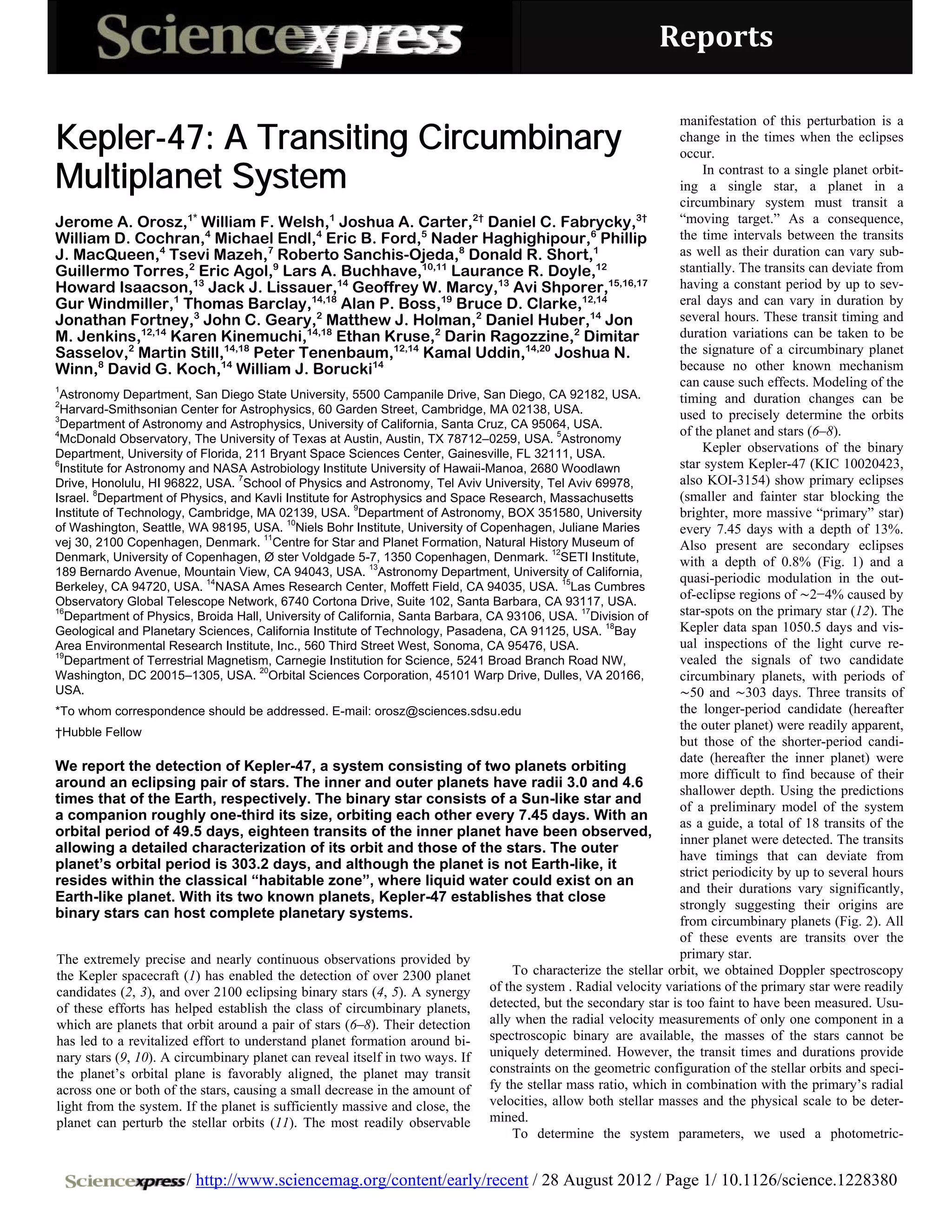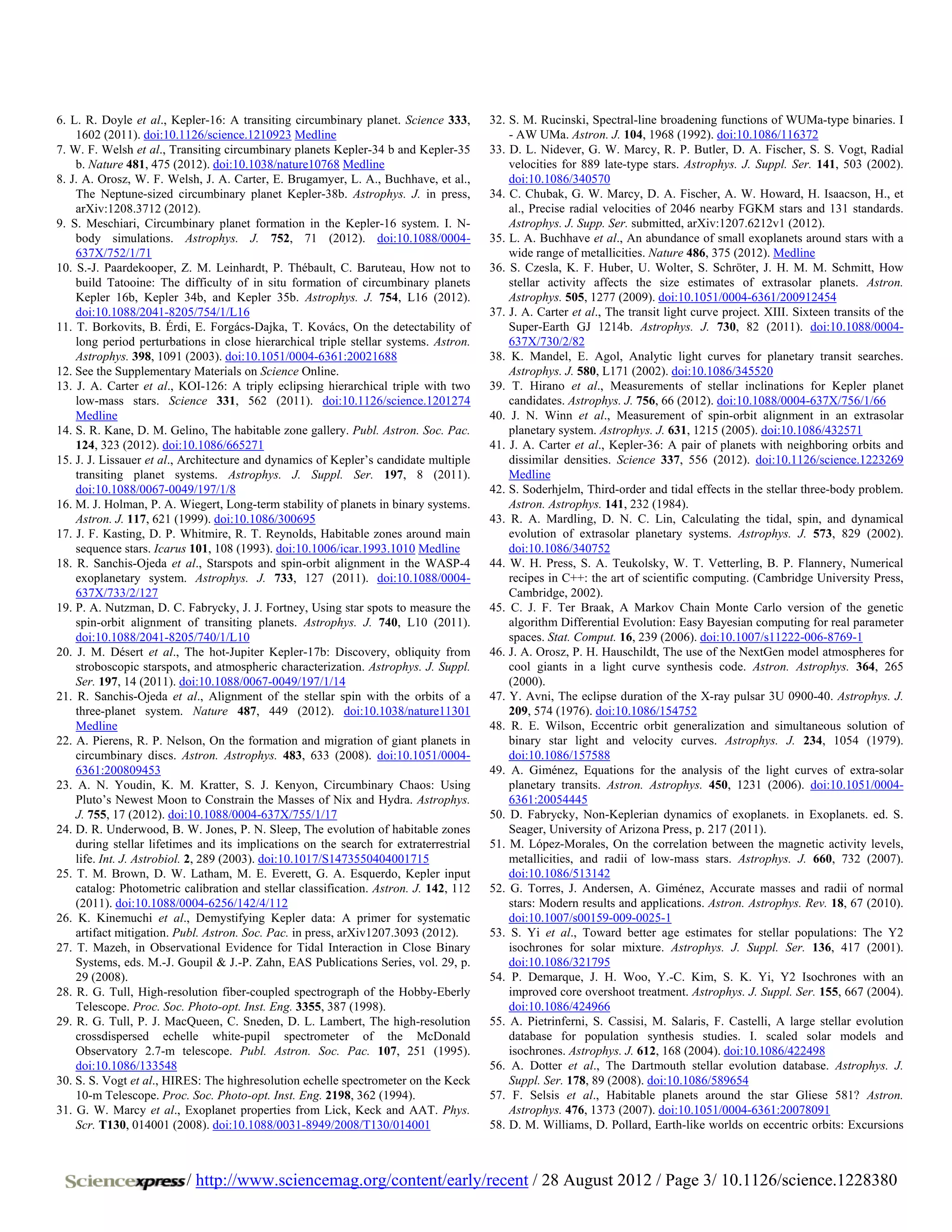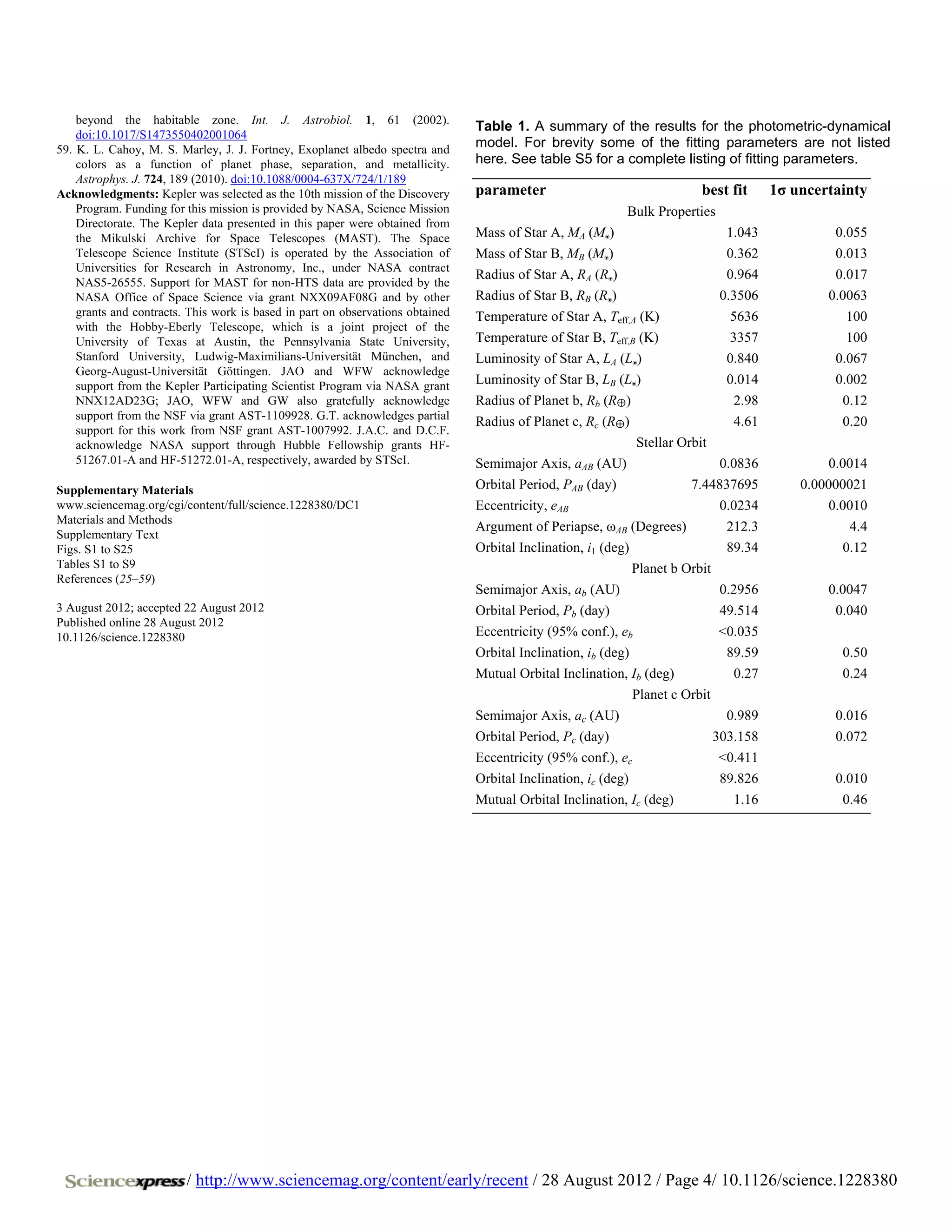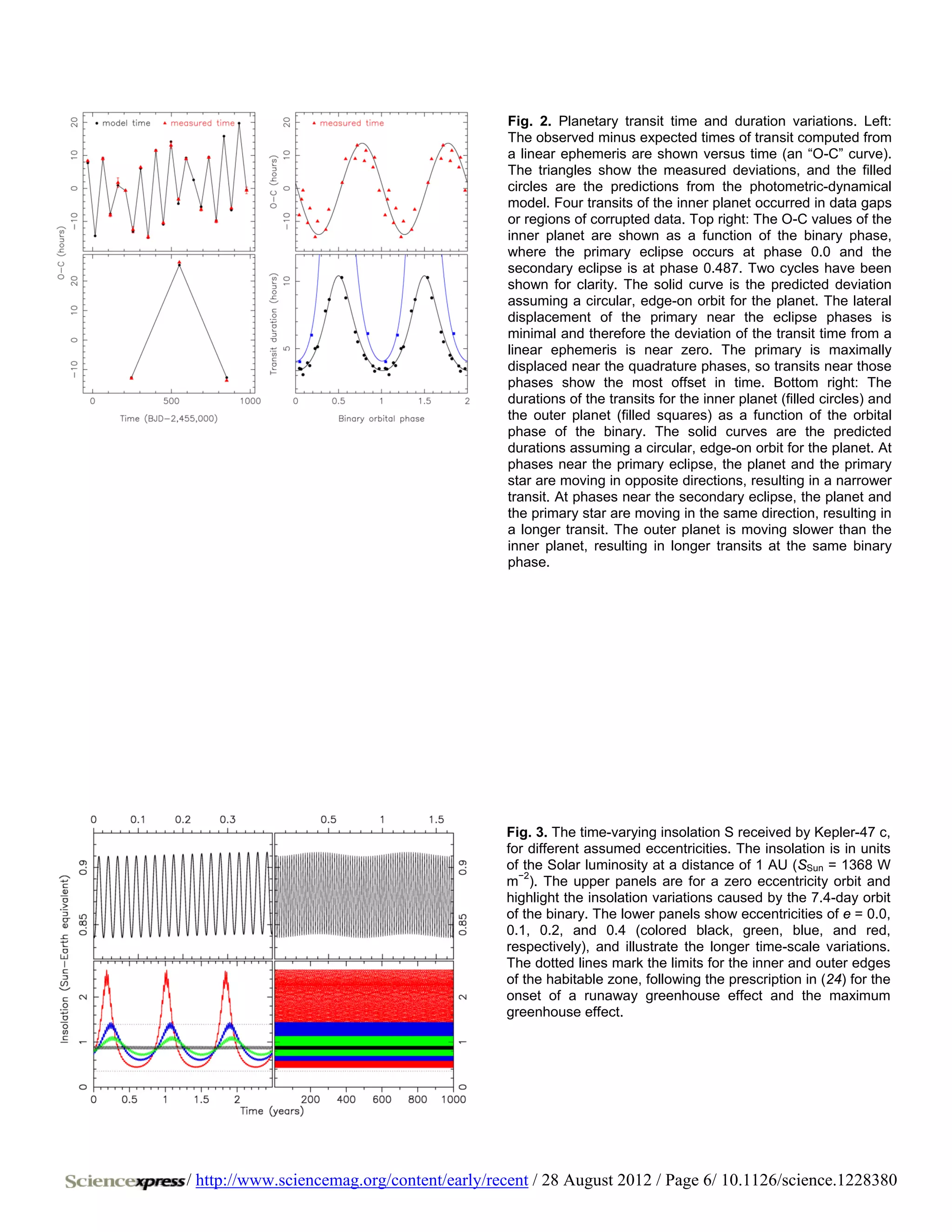The document reports on the Kepler-47 system which consists of two planets orbiting an eclipsing binary star system. The inner planet has a radius of 3.0 Earth radii and orbits every 49.5 days, while the outer planet has a radius of 4.6 Earth radii and orbits every 303.2 days. Eighteen transits of the inner planet were observed, allowing for a detailed characterization of its orbit and that of the binary stars. The timing and duration of the transits vary, indicating the planets orbit both stars in the binary system. Kepler-47 establishes that circumbinary planetary systems can exist around close binary star systems.

![dynamical model (13) similar to that used for the four previously known are large modulations due to star-spots, and the data contain correlated
transiting circumbinary planets (6–8). This model assumes spherical “red” noise, making small, non-periodic transit detection challenging.
bodies interacting via Newtonian gravity (12), and is used to fit the radi- The marginal evidence at the present time is insufficient to place confi-
al velocity data and the Kepler time-series photometry. We determined dence on any additional candidate planet(s).
the stellar masses as described above, and the relative sizes of the bodies The primary star is similar to the Sun in both mass and radius, and
from the eclipses and transits in the light curve. Information on the incli- dominates the luminosity of the binary system, having 60 times the bo-
nation, eccentricity, and mutual inclination of the planetary orbits is also lometric luminosity of the secondary star (or 176 times the brightness in
implicit in the combination of photometric and radial-velocity data. the Kepler bandpass). A spectroscopic analysis gives an effective tem-
Gravitational perturbations caused by the planets on the stars and on perature of 5640 ± 100 K for the primary star (table S2), with a
each other could, in principle, also constrain the masses, but for Kepler- metallicity slightly less than solar ([M/H] = −0.25 ± 0.08 dex). The star’s
47 the expected masses of the planets are too small to create a measura- rotation period as determined from the star-spot modulation in the light
ble effect over the time span of our data. The small radii of the transiting curve (12) is only 4% longer than the orbital period, suggesting that the
objects strongly suggests they are of planetary mass (Table 1); dynam- spin and orbital angular momenta have been synchronized by tidal inter-
ical considerations described below make this conclusion secure. actions. Supporting this interpretation, the obliquity of the primary star
The inner planet, Kepler-47 b, is the smallest transiting circumbinary (the angle between the spin and orbital axes) must be smaller than about
planet yet detected, with a radius of 3.0 ± 0.1 Earth radii. Its mass is too 20°, based on the observable effects of the secondary star eclipsing star-
small to be directly measured, but a 3σ upper limit of 2 Jupiter masses spots on the primary star (12, 18–21). Star-spot crossings also perturb
has been determined based on the nondetection of timing variations of the shape and depth of the primary eclipses, leading to systematic trends
the stellar orbit (12). Because the planet’s mass is unknown, its density in the eclipse times, and limit the precision with which one can infer the
is also unknown and it is not possible to distinguish between a rocky planets’ masses. In addition, the loss of light due to star-spots causes
composition and a more volatile-enriched composition. We can make a eclipses to appear slightly deeper than they would for an unspotted star,
relation for planets in the Solar System (15) yielding ~7−10 Earth mass-
plausible mass etimate by using both an empirical mass-radius relation biasing the determination of the stellar and planetary radii too high by a
es or ~0.4−0.6 Neptune masses. The planet’s 49.5-day orbital period is
based on transiting exoplanets (14) and a limited empirical mass-radius few percent.
6.6 times the period of the stellar binary. This is ~77% longer than the
With Kepler-47 b and c, there are six confirmed transiting
circumbinary planets currently known. Their orbital periods relative to
their host binary stars show no tendency to be in resonance, and their
critical period (28 d) within which the planet would be susceptible to radii are Saturn-size and smaller. Given that Jupiter-size planets are easi-
dynamical instability due to interactions with the stars (16). While this er to detect, their absence in the Kepler data suggests that the formation
77% margin is notably larger than for the other known transiting and migration history of circumbinary planets may disfavor Jupiter-mass
circumbinary planets, i.e., 14%, 21%, 24%, 42% for Kepler 16, 34, 35, planets orbiting close to the stars, in accord with (22).
and 38, respectively, the planet is still somewhat close to the instability The planets in Kepler-47 are expected to have formed much farther
limit, a feature shared by all known transiting circumbinary planet sys- out than their present orbits, at locations where the conditions for the
tems. formation of giant planets are more favorable (9, 10). The planets have
The outer planet, Kepler-47 c, has a radius of 4.6 ± 0.2 Earth radii, likely migrated to their current orbits as a result of interactions with the
making it slightly larger than the planet Uranus. As before, the planet’s circumbinary disk. The multiplicity and coplanarity of the orbits
mass is too small to be measured directly, and we derived a 3σ upper
mass of ~16−23 Earth masses or ~0.9−1.4 Neptune masses, using these
strengthens the argument for a single-disk formation and a migration
limit of 28 Jupiter masses (12). Based on its radius, we find a plausible scenario for circumbinary planetary systems. However, unlike orbits
around a single star, the environment around a binary star is much more
empirical mass-radius relations (14, 15). With only 3 transits currently dynamic and tends to augment planet-planet interactions. The relatively
available, the outer planet’s orbital eccentricity is poorly constrained. A large distance between the orbits of the inner and outer planets in the
perfectly circular orbit would fit the data, and a low-eccentricity orbit Kepler-47 system is consistent with requirements for dynamical stability
seems plausible given the low eccentricity of the stellar binary (e = (23).
0.023) and of planet b (e < 0.035). The photometric-dynamical model The previously detected transiting circumbinary planet systems show
provides only an upper limit on the eccentricity, e < 0.4 with 95% confi- no evidence for more than a single planet. The multi-planet nature of the
dence, and the requirement of long-term stability only rules out eccentri- Kepler-47 system establishes that despite the chaotic environment
cities larger than 0.6 (12). around binary stars, planetary systems can form and persist close to the
Due to the orbital motion of the stars, the outer planet is subject to binary, and invites a broader investigation into how circumbinary planets
variations in the incident stellar flux (i.e., insolation), even if the planet’s compare to planets and planetary systems around single stars.
Sun-Earth insolation, and varies by ~9%. This places Kepler-47 c well
orbit is circular (Fig. 3). The average insolation is similar to the amount
the Earth receives from the Sun: for a circular orbit it is 87.5% of the References and Notes
1. D. G. Koch et al., Kepler mission design, realized photometric performance,
within the classical “habitable zone”, defined as the range of distances and early science. Astrophys. J. 713, L79 (2010). doi:10.1088/2041-
8205/713/2/L79
from the host star(s) where liquid water could persist on the surface of an
2. W. J. Borucki et al., Kepler planet-detection mission: Introduction and first
Earth-like planet (17). While Kepler-47 c is probably a gas giant and results. Science 327, 977 (2010). doi:10.1126/science.1185402 Medline
thus not suitable for life, its location is notable as it demonstrates that 3. N. M. Batalha et al., Planetary candidates observed by Kepler, III: Analysis of
circumbinary planets can exist in habitable zones. Although the defini- the first 16 months of data. Astrophys. J. Suppl. Ser. submitted,
tion of the habitable zone assumes a terrestrial planet atmosphere which arXiv1202.5852 (2012).
does not apply for Kepler-47 c, large moons, if present, would be inter- 4. A. Prša et al., Kepler eclipsing binary stars. I. catalog and principal
esting worlds to investigate. characterization of 1879 eclipsing binaries in the first data release. Astron. J.
A 0.2% deep transit-like event is present at time 2,455,977.363 141, 83 (2011). doi:10.1088/0004-6256/141/3/83
(BJD) that is not caused by either of the two planets. A search for addi- 5. R. W. Slawson et al., Kepler eclipsing binary stars. II. 2165 eclipsing binaries
tional transits has revealed several more tentative transit events (12), but in the second data release. Astron. J. 142, 160 (2011). doi:10.1088/0004-
6256/142/5/160
we caution that the star is faint (the Kepler magnitude is 15.178), there
/ http://www.sciencemag.org/content/early/recent / 28 August 2012 / Page 2/ 10.1126/science.1228380](https://image.slidesharecdn.com/kepler-47atransitingcircumbinary-120829163146-phpapp02/75/Kepler-47-a-transiting_circumbinary-2-2048.jpg)



